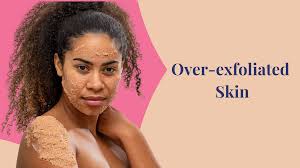
Over Exfoliated Skin: What To Do When You Scrub Too Much
Are you over exfoliated because you scrubbed your face too hard or used too many exfoliants in your skin care routine? If so you may have skin bumps, skin stinging, a rash, or even worse – scabs. If your skin hurts or is purging after over exfoliating, this blog will tell how what to do. I always explain to my patients with dry and sensitive skin not to over exfoliate. It is so easy to over exfoliate when you use a facial brush, too many exfoliants, or you are using Vitamin C or retinoids.
My advice is to take our skin type quiz and review the custom skincare routine we will give you so you can see how many exfoliants should be in your skin routine to avoid over-exfoliation.
Overexfoliating Skin
If you use a rough washcloth and rub too hard, or you overuse a facial brush or facail scrub, this thins the top layer of the skin. Your skin in most cases does not need much help exfoliating. You see- your skin naturally exfoliates in a process called desquamation. Also, many skin care products have ingredients that exfoliate skin even when they are not described as exfoliants. This is why it is very easy to over-exfoliate! For example- did you know that Vitamin C exfoliates skin? Adding Vitamin C to a regimen that already has 2 exfoliants can lead to skin inflammation so that your skin actually hurts and becomes sensitive.
To avoid over exfoliating you should not use more than 2 exfoliants in your daily skincare routine. You can find a list of skincare products that are exfoliants here.
It is Bad to Exfoliate Too Much
Over exfoliation is bad for skin because it disrupts the keratinization process.
You do not want to over-exfoliate because that can lead to skin problems such as dryness and acne.
Over-exfoliating can damage your skin by:
injuring your skin barrier
disrupting the normal keratinization process
causing inflammation
Skin Types at Risk For Over Exfoliation
There are certain skin types that need to be careful when they exfoliate to avoid causing skin problems. When you take our skin type quiz, we will tell you which Baumann Skin Type you are and give you advice on products, your skin, and your routine. There are 12 of the 16 Baumann Skin Types need to worry about over exfoliating. Take the skin type quiz to get a custom routine, shop by your skin type, see and how many exfoliants you should use.
ensitive Skin
Very sensitive skin types are at a high risk of over-exfoliation- especially acne, rosacea and stinging skin types. Unless we tell you otherwise in your custom skincare routine, you should not exfoliate with scrubs and peels that are not in your daily routine. Most resistant skin types can exfoliate 2-3 times a week, and resistant skin types can exfoliate 2 times a day.
Dry Skin
Exfoliating can dry out your skin- so do not use any exfoliators that we do not recommend in your custom skin care regimen. Always exfoliate less in the winter when the climate is dry and cold, because you need the top layers of the skin to help your hold onto water.
Signs of Over Exfoliated Skin
How To Know If You Are Over-Exfoliating Your Skin? There are signs of over exfoliation that should warn you to stop exfoliating. Over exfoliated skin can have stinging, itching, skin bumps, and redness. Over exfoliating can cause breakouts and too much exfoliation can even lead to large pores.
Signs of over exfoliation are:
acne breakouts
purging
skin bumps
clogged pores
scabs
sensitive skin
shiny skin
skin dehydration
stinging skin
tender skin
Treatments for over exfoliated skin
Treating Hyperexfoliated Skin
Treating over-exfoliated skin properly is important to prevent purging, bumps and other side effects from exfoliation.
If you have over exfoliation damage, these are the 10 steps to treat and soothe the skin.
Remove all exfoliants from your skin care routine until your skin returns to normal.
Do not use Vitamin C
Do not use hydroxyacids
Do not use retinoids like retinol
Do not use a facial brush or loofa or scrub
Apply a soothing barrier repair moisturizer such as Zerafite Soothing and Calming Face Cream.
Apply a soothing oil such as Argan Oil overnight or a soothing mask.
Use a gentle non-foaming cleanser and cleanse with cool or room temperature water- not hot.
Avoid friction
Avoid extreme temperatures like cold or hot water
Best Moisturizers to Treat Over-exfoliated Skin
These moisturizers have soothing ingredients, ceramides, fatty acids, and cholesterol that help repair your skin barrier.
[[M04]]
Best Soothing Oils
These oils containing anti-inflammatory fatty acids that help soothe skin. This are best for dry skin types that have exfoliated too much.
[[T10]]
Best Soothing Masks
These masks can be used every night until your skin feels better.
[[MK06]]
When Will Over Exfoliated Skin Heal
How long to heal over exfoliated skin? Over exfoliated skin will take 1- 5 days to heal depending on how severe it is. If you stop all exfoliants, the skin should begin to feel better in 2 days. It may take an entire week to heal. If your skin is stinging or itching, applying a soothing oil overnight can help. Give your skin 2 weeks before restarting any exfoliating skin care products.
Scabs from over exfoliation can take 5 days while shininess goes away in 1-2 days. Bumps from exfoliation can take a week or more to heal depending on your skin type and how over exfoliated you are.
Exfoliating too much or incorrectly can damage your skin. This why you need to get skincare routine advice from us for your Baumann Skin Type® .This will keep you from wasting time and money on the wrong skin care products and too many exfoliants.


